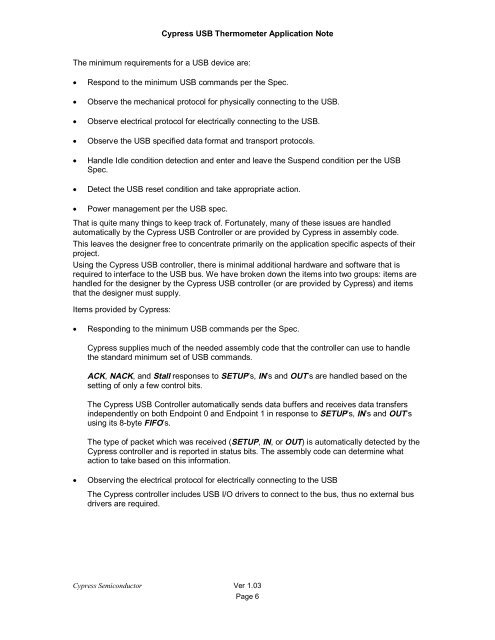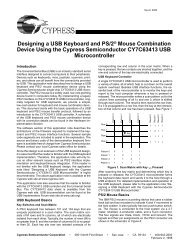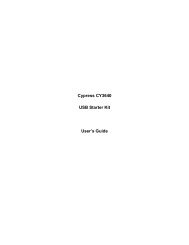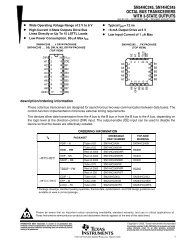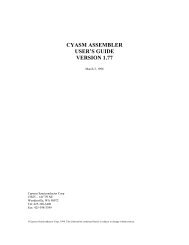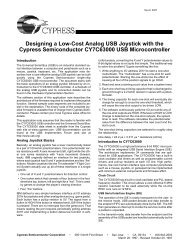Designing a Universal Serial Bus (USB) Device Using the Cypress ...
Designing a Universal Serial Bus (USB) Device Using the Cypress ...
Designing a Universal Serial Bus (USB) Device Using the Cypress ...
You also want an ePaper? Increase the reach of your titles
YUMPU automatically turns print PDFs into web optimized ePapers that Google loves.
<strong>Cypress</strong> <strong>USB</strong> Thermometer Application Note<br />
The minimum requirements for a <strong>USB</strong> device are:<br />
• Respond to <strong>the</strong> minimum <strong>USB</strong> commands per <strong>the</strong> Spec.<br />
• Observe <strong>the</strong> mechanical protocol for physically connecting to <strong>the</strong> <strong>USB</strong>.<br />
• Observe electrical protocol for electrically connecting to <strong>the</strong> <strong>USB</strong>.<br />
• Observe <strong>the</strong> <strong>USB</strong> specified data format and transport protocols.<br />
• Handle Idle condition detection and enter and leave <strong>the</strong> Suspend condition per <strong>the</strong> <strong>USB</strong><br />
Spec.<br />
• Detect <strong>the</strong> <strong>USB</strong> reset condition and take appropriate action.<br />
• Power management per <strong>the</strong> <strong>USB</strong> spec.<br />
That is quite many things to keep track of. Fortunately, many of <strong>the</strong>se issues are handled<br />
automatically by <strong>the</strong> <strong>Cypress</strong> <strong>USB</strong> Controller or are provided by <strong>Cypress</strong> in assembly code.<br />
This leaves <strong>the</strong> designer free to concentrate primarily on <strong>the</strong> application specific aspects of <strong>the</strong>ir<br />
project.<br />
<strong>Using</strong> <strong>the</strong> <strong>Cypress</strong> <strong>USB</strong> controller, <strong>the</strong>re is minimal additional hardware and software that is<br />
required to interface to <strong>the</strong> <strong>USB</strong> bus. We have broken down <strong>the</strong> items into two groups: items are<br />
handled for <strong>the</strong> designer by <strong>the</strong> <strong>Cypress</strong> <strong>USB</strong> controller (or are provided by <strong>Cypress</strong>) and items<br />
that <strong>the</strong> designer must supply.<br />
Items provided by <strong>Cypress</strong>:<br />
• Responding to <strong>the</strong> minimum <strong>USB</strong> commands per <strong>the</strong> Spec.<br />
<strong>Cypress</strong> supplies much of <strong>the</strong> needed assembly code that <strong>the</strong> controller can use to handle<br />
<strong>the</strong> standard minimum set of <strong>USB</strong> commands.<br />
ACK, NACK, and Stall responses to SETUP’s, IN’s and OUT’s are handled based on <strong>the</strong><br />
setting of only a few control bits.<br />
The <strong>Cypress</strong> <strong>USB</strong> Controller automatically sends data buffers and receives data transfers<br />
independently on both Endpoint 0 and Endpoint 1 in response to SETUP’s, IN’s and OUT’s<br />
using its 8-byte FIFO’s.<br />
The type of packet which was received (SETUP, IN, or OUT) is automatically detected by <strong>the</strong><br />
<strong>Cypress</strong> controller and is reported in status bits. The assembly code can determine what<br />
action to take based on this information.<br />
• Observing <strong>the</strong> electrical protocol for electrically connecting to <strong>the</strong> <strong>USB</strong><br />
The <strong>Cypress</strong> controller includes <strong>USB</strong> I/O drivers to connect to <strong>the</strong> bus, thus no external bus<br />
drivers are required.<br />
<strong>Cypress</strong> Semiconductor Ver 1.03<br />
Page 6


